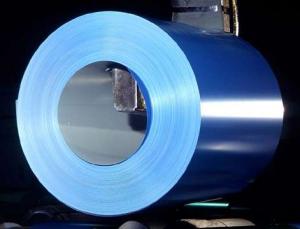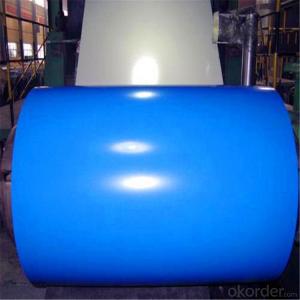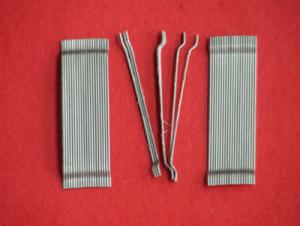PPGI Applications of Prepainted Galvanized SteelCoil
- Loading Port:
- Tianjin
- Payment Terms:
- TT OR LC
- Min Order Qty:
- 3232 m.t.
- Supply Capability:
- 32342 m.t./month
OKorder Service Pledge
OKorder Financial Service
You Might Also Like
1.Structure of Prepainted Galvanized steel Coil :
With Gi as base metal,after pretreatmet (degrease and chemical treatment) and liquid dope with several Layers of color,then after firing and cooling,finally the plate steel is called pre-painted galvanized steel ( PPGI) .Pre-painted galvanized steel is good capable of decoration ,molding,corrosion resistance
2.Main Features of Prepainted Galvanized steel Coil:
• Excellent process capability
• Smooth and flat surface
• Workability, durability
• Excellent heat resistance performance
• High strength
• Good formability
• Good visual effect
3.Prepainted Galvanized steel Coil Images

4.Prepainted Galvanized steel Coil Specification
Standard:ASTM, GB,JIS,JIS G3302 ASTM 755 EN10169
Grade: DX51D CGCC CS
Thickness: 0.13mm~3.0mm,
Width: 1250,600-1250mm
Coil weight:3-12 MT
Coil ID:508/610mm
Chemical composition:
Thickness | 0.16mm-1.6mm |
Width | 600mm-1250mm,or customized |
Coil ID | 508mm/610mm |
Zinc-Coating | 60-275g/m2 |
Grade | Q195-Q235 and SPCC,SPCD,SPCE,SGCC(DX51D+Z),SGCD(DX52D+Z),ETC |
Coil Weight | Customized |
Color | RAL number or sample color |
Standard | JIS G3302,JIS G3312,ASTM A653M/A924M 1998 |
Capacity | about 15,000 tons per month for coil product |
Surface structure | Galvanized,Zero spangle,regular spangle or normal spangle |
Coating | Topside:5micron primer+15-20microns polyester |
Backside:5-8micron primer epoxy | |
Surface treatment:chromated,oiled, non-oiled |
5.FAQ of Prepainted Galvanized steel Coi
We have organized several common questions for our clients,may help you sincerely:
1.How do you control your quality
We have established the international advanced quality management system,every link from raw material to final product we have strict quality test;We resolutely put an end to unqualified products flowing into the market. At the same time, we will provide necessary follow-up service assurance.
2.how long we will receive the goods ?
After receiving your deposit or workable lc ,our normal shipment date is 15-20days,and it takes around 28 days to reach your port of destination. But is up to different destination
3. what is your moq
Normally our moq is 25per size ,but it is up to different size
- Q: How is steel used in the production of marine equipment and vessels?
- Steel is widely used in the production of marine equipment and vessels due to its exceptional strength, durability, and corrosion resistance. It is used to construct the hulls, frames, and superstructures of ships, ensuring they can withstand the harsh marine environment. Additionally, steel is used to manufacture various components such as propellers, shafts, and rudders, enhancing the performance and maneuverability of marine vessels.
- Q: How is steel made and processed to create various steel products?
- Steel is made through a process called the basic oxygen furnace (BOF) or the electric arc furnace (EAF). In the BOF method, iron ore is melted with scrap metal and limestone in a furnace, then oxygen is blown through the mixture to remove impurities. The resulting molten iron is mixed with alloying elements like carbon, manganese, and chromium to create different grades of steel. Alternatively, in the EAF method, recycled steel is melted using an electric arc. Once the steel is produced, it goes through various processing steps to create different steel products. These steps may include casting the molten steel into forms like slabs, billets, or blooms, which are then hot-rolled or cold-rolled into sheets, bars, or coils. Additional processes like tempering, annealing, galvanizing, or coating may be applied to enhance the steel's properties or protect it against corrosion. Finally, the steel products are cut, shaped, and finished to meet the specific requirements of industries such as construction, automotive, or manufacturing.
- Q: How is steel used in the production of mining equipment?
- Steel is commonly used in the production of mining equipment due to its strength, durability, and resistance to harsh conditions. It is used to manufacture various components such as buckets, shovels, drill bits, and machinery frames, ensuring they can withstand the rigorous demands of the mining industry.
- Q: How is steel sheet metal formed?
- Steel sheet metal is formed through a process called cold rolling, where the steel is passed through a series of rollers to reduce its thickness and increase its length. This process allows for the creation of thin and flat sheets of steel that are used in various industries for manufacturing purposes.
- Q: How is steel sheet metal stamped for automotive parts?
- Steel sheet metal is stamped for automotive parts through a process called sheet metal stamping. This involves using specialized machines and tooling to cut, bend, and shape the steel into the desired automotive component. The process typically includes steps such as blanking, piercing, forming, and trimming to achieve the required shape and dimensions.
- Q: How do steel products contribute to the agriculture and farming sector?
- Steel products contribute to the agriculture and farming sector in several ways. Firstly, steel is used in the manufacturing of machinery and equipment essential for agricultural activities, such as tractors, combines, plows, and irrigation systems. These machines help increase efficiency, reduce labor, and improve productivity on farms. Additionally, steel structures, such as barns, silos, and storage facilities, provide durable and secure spaces for storing crops, livestock, and equipment. Steel is known for its strength, durability, and resistance to weather conditions, making it ideal for protecting agricultural resources. Furthermore, steel is used in the construction of infrastructure such as bridges and roads, which play a crucial role in connecting farms to markets and facilitating the transportation of goods. This infrastructure ensures that agricultural products can reach consumers in a timely and efficient manner. Overall, steel products contribute significantly to the agriculture and farming sector by enhancing productivity, providing storage solutions, and supporting the necessary infrastructure for the smooth functioning of the industry.
- Q: How does steel tube bending work?
- Steel tube bending works by using specialized machinery and techniques to apply force on a steel tube, causing it to bend into a desired shape or angle. The tube is typically secured in place and a bending tool or die is used to exert pressure on the tube, gradually forming it into the desired curve. The amount of force applied and the tool's shape determine the degree and radius of the bend. This process is commonly used in various industries to create custom-shaped steel tubes for a wide range of applications.
- Q: How are steel products used in the construction of theme-based wildlife safari parks?
- Steel products are used in the construction of theme-based wildlife safari parks for various purposes such as building structures, enclosures for animals, walkways, fencing, and support systems. Steel's strength, durability, and versatility make it an ideal material for creating safe and secure habitats for animals, as well as for constructing infrastructure that can withstand the elements and heavy visitor traffic.
- Q: What are the different types of steel products used in the manufacturing of luxury goods?
- Some of the different types of steel products commonly used in the manufacturing of luxury goods include stainless steel, Damascus steel, and carbon steel.
- Q: What are the different types of steel sheets and their uses in the automotive industry?
- There are various types of steel sheets used in the automotive industry, including cold-rolled, hot-rolled, galvanized, and advanced high-strength steel (AHSS). Cold-rolled steel sheets are often used for body panels and other visible parts due to their smooth surface finish and high dimensional accuracy. Hot-rolled steel sheets are commonly used for structural components, such as chassis and frames, as they offer excellent strength and durability. Galvanized steel sheets, which are coated with a layer of zinc, provide corrosion resistance and are commonly used for underbody parts and other areas exposed to harsh conditions. Advanced high-strength steel sheets are specifically designed for enhanced strength and reduced weight. They are used in critical safety components, such as door beams and crash structures, to improve occupant protection while maintaining fuel efficiency.
Send your message to us
PPGI Applications of Prepainted Galvanized SteelCoil
- Loading Port:
- Tianjin
- Payment Terms:
- TT OR LC
- Min Order Qty:
- 3232 m.t.
- Supply Capability:
- 32342 m.t./month
OKorder Service Pledge
OKorder Financial Service
Similar products
Hot products
Hot Searches
Related keywords






























